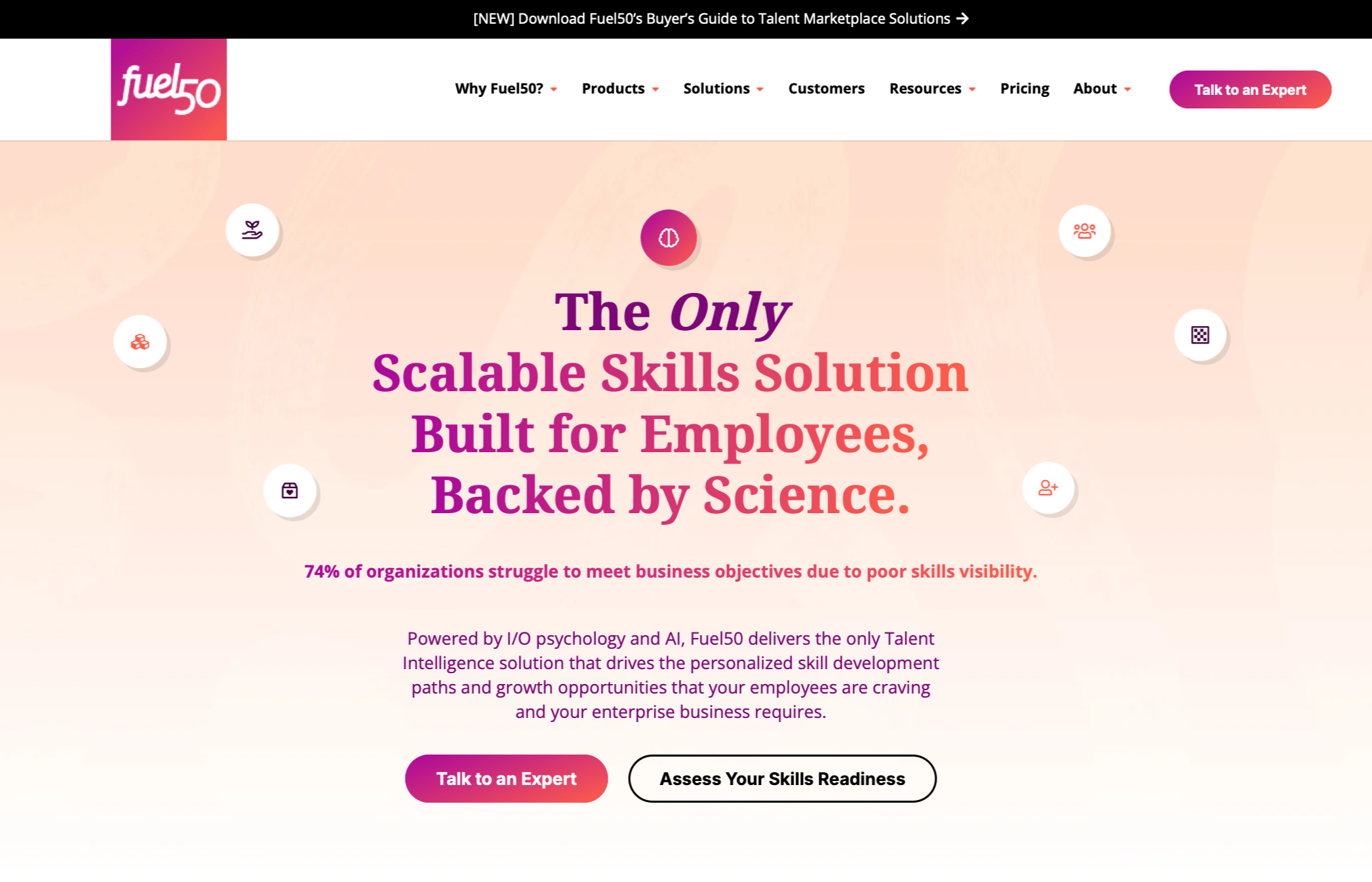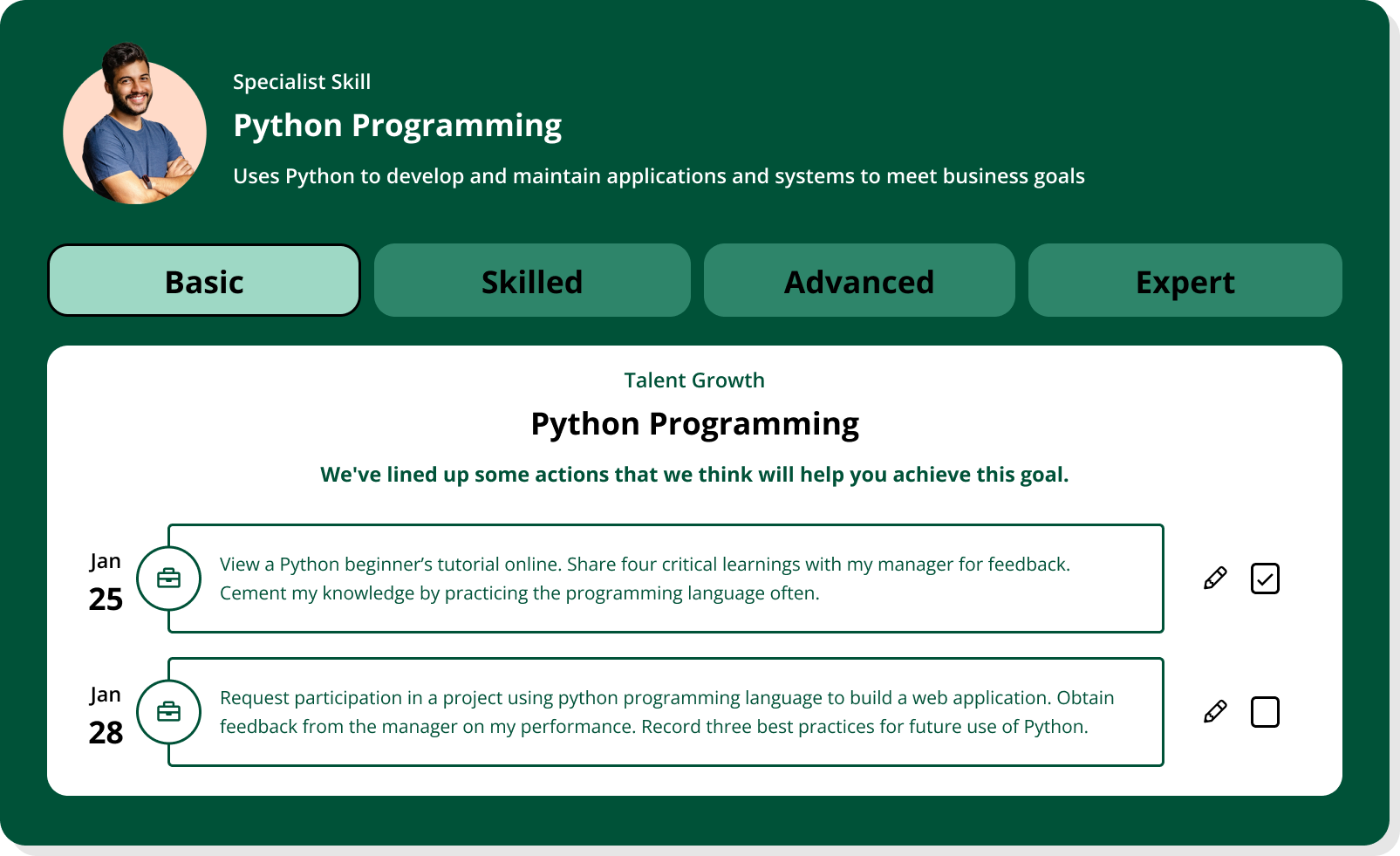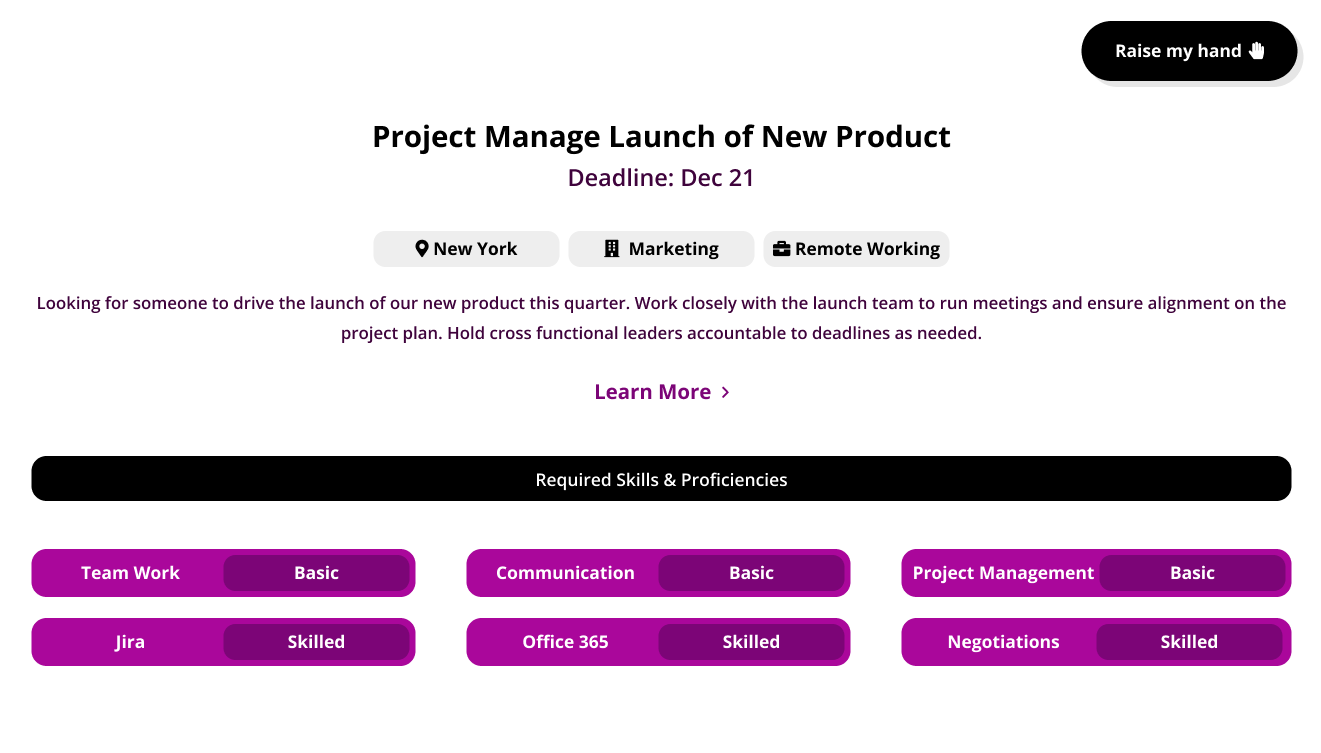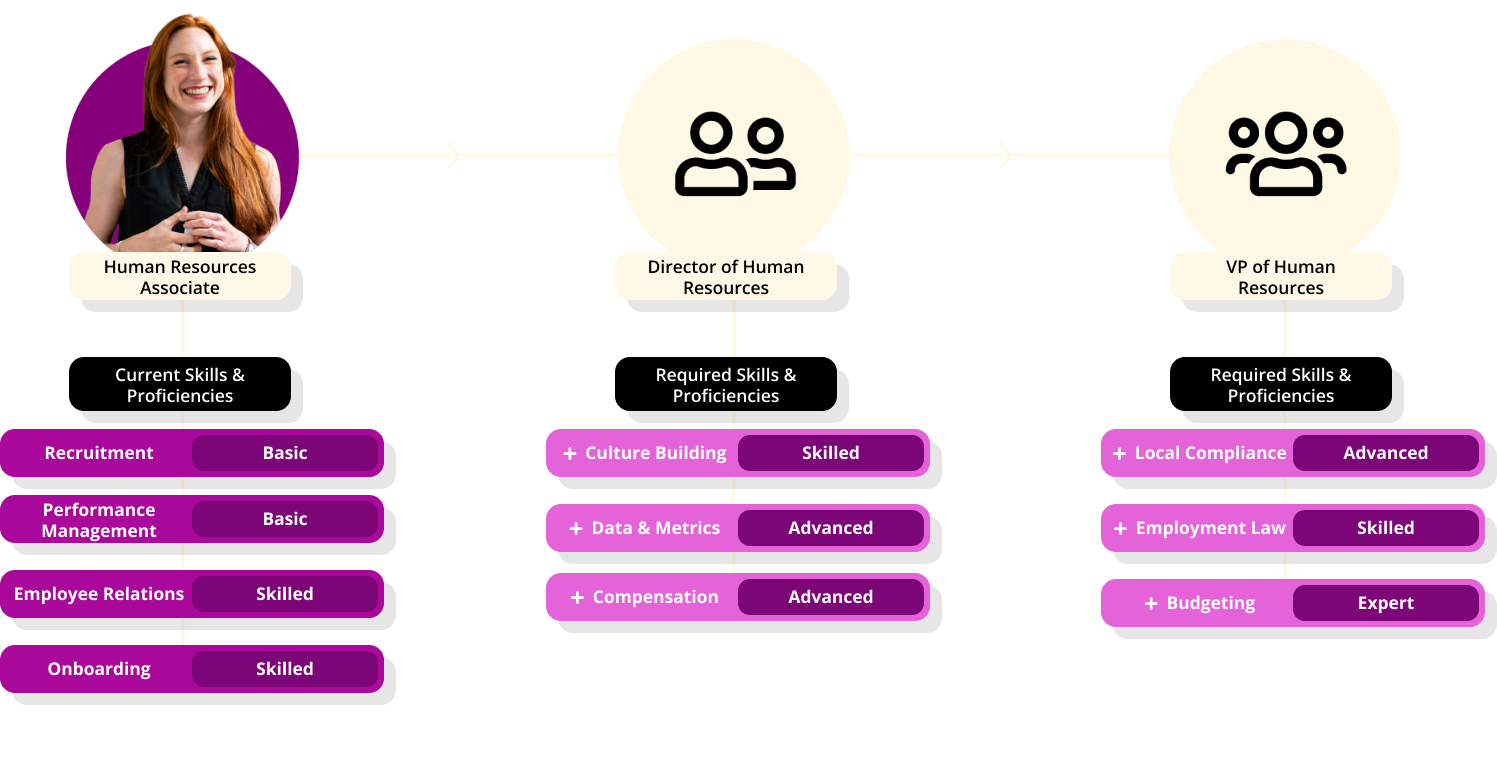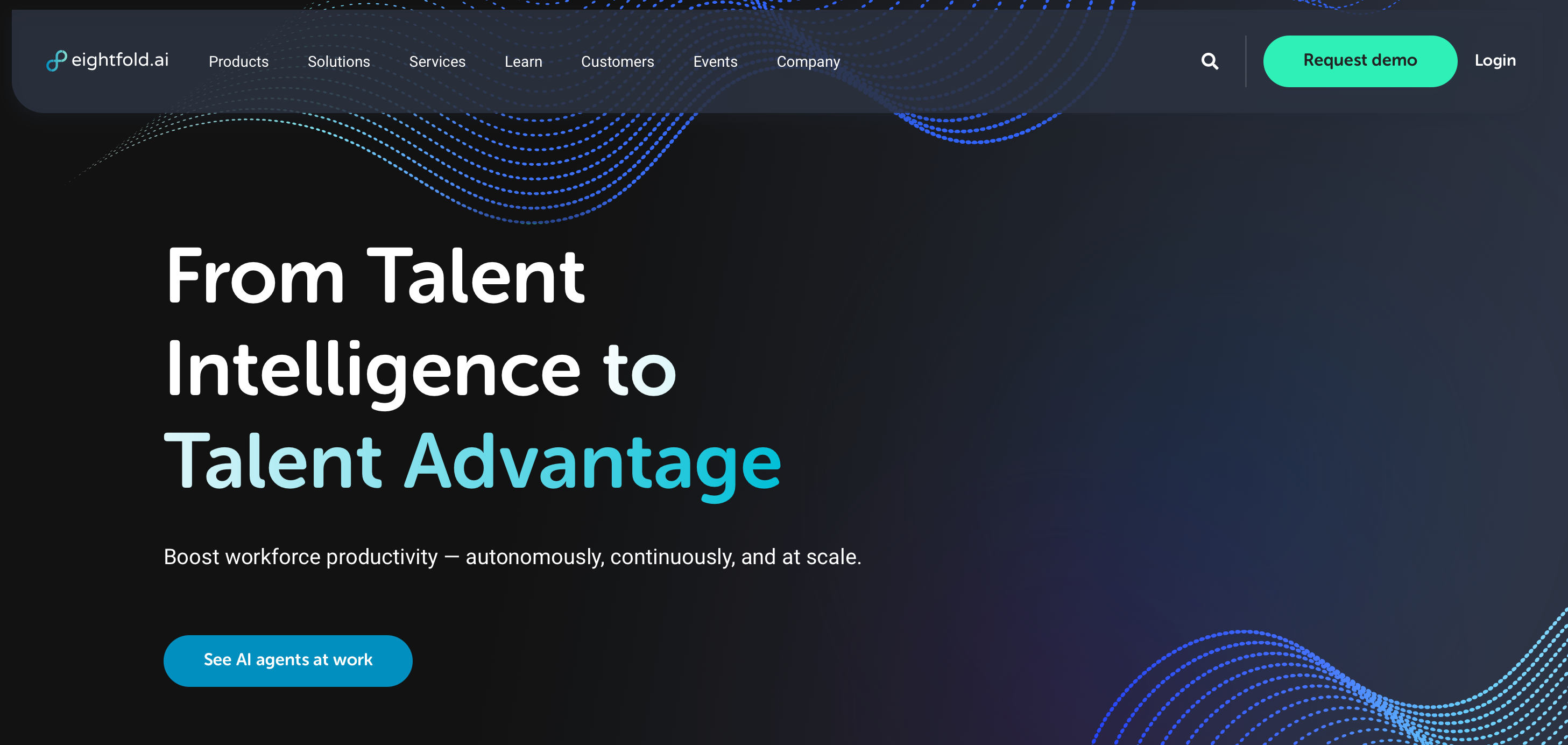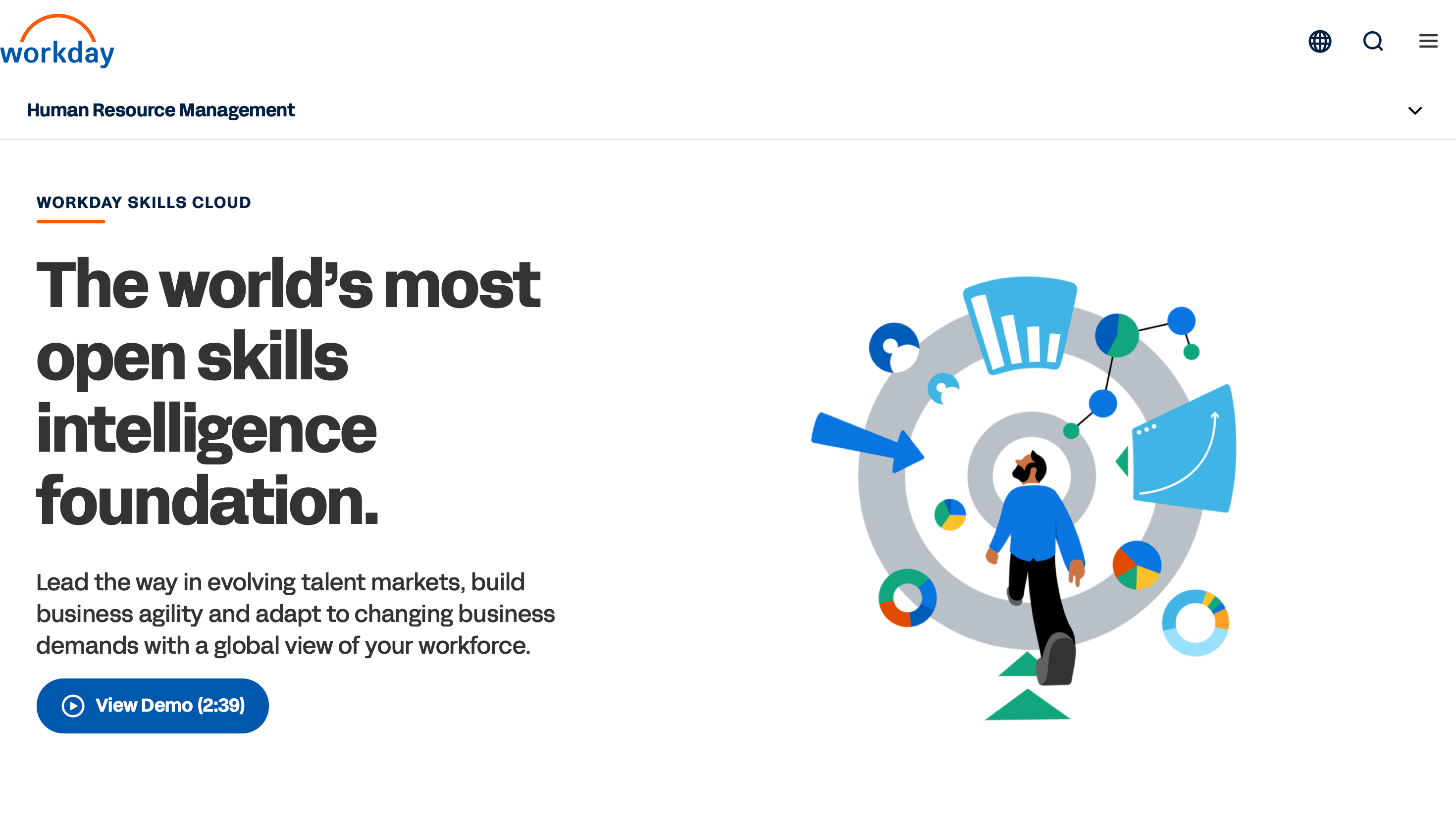If you’re in the market for a Gloat alternative—one that delivers deeper skill mapping, faster time to value, or a roadmap more closely tied to your unique upskilling goals—this is the guide for you.
We’ve scoured G2’s User Satisfaction Ratings (as of March 24, 2025) to compare four top contenders—Fuel50, 365Talents, Eightfold AI, and Workday HCM—against Gloat’s benchmarks.
By grounding our evaluation in peer-reviewed feedback, you’ll see exactly where each platform succeeds (and where they fall short) on metrics that matter most, like:
- Product direction: Do the vendor’s capabilities support your long-term talent strategy?
- Skills mapping & skills library: How comprehensive and actionable are the competency frameworks?
- Ease of setup & admin: Can you pilot a program in months instead of a year?
- Time to value: What percentage of customers hit ROI in under 12 months?
By the end of this article, you’ll know which solution can give you the confidence that your platform will evolve alongside your needs, close those stubborn skills gaps, and have users up and running in a fraction of the time.
Top 4 Gloat alternatives that’ll help your organization address skills gaps
| Comparative Element | Fuel50 | 365Talents | Eightfold AI | Workday HCM |
| Star Rating | 4.5/5 | 4.5/5 | 4.2/5 | 4.1/5 |
| Product Direction (% positive) | 100% | 94% | 86% | 83% |
| Skill Mapping (% positive) | 92% | 91% | N/A | N/A |
| Skills Library (% positive) | 94% | 89% | N/A | N/A |
| Ease of Admin (% positive) | 85% | N/A | 81% | 74% |
| Ease of Setup (% positive) | 83% | N/A | 81% | 73% |
| Quality of Support (% positive) | 88% | N/A | 83% | 81% |
| Performance (% positive) | 95% | N/A | 84% | 85% |
| Dashboards (% positive) | 81% | N/A | 77% | N/A |
| Likelihood to Recommend (% positive) | 87% | N/A | 83% | 81% |
| Career Development (% positive) | 91% | N/A | N/A | 87% |
| % Live in (< 3 months) | 42% | 10% | 27% | 25% |
| Average Go-Live (months) | 6 | 6 | 6 | 7 |
| % ROI (≤ 12 months) | 30% total (10% in ≤ 6 months; 20% in 7–12 months) | 30% total (10% in ≤ 6 months; 20% in 7–12 months) | 33% total (20% in ≤ 6 months; 13% in 7–12 months) | 38% total (18% in ≤ 6 months; 20% in 7–12 months) |
| Average ROI (months) | 15 | 17 | 17 | 19 |
All four Gloat alternatives demonstrate strong customer satisfaction and viable paths to internal mobility and skills management.
Fuel50 stands out with the highest Product Direction score (100%), best-in-class Skill Mapping (92%), and Skills Library (94%) ratings, evidencing that its roadmap and competency framework resonate deeply with users.
While 365Talents offers comparable skill-centric scores across the board, Fuel50’s slightly higher percentages reflect more granular taxonomies and more cohesive product iterations. Meanwhile, Eightfold AI’s strength lies in enterprise-scale performance and breadth of features, but its lack of publicly reported skill module scores means Fuel50 retains the edge in precise skills mapping. Workday HCM excels as a unified, enterprise-grade suite but trails in specialized skill management metrics, ease of setup (73% versus Fuel50’s 83%), and overall time to value.
In short, while all four alternatives are solid choices, Fuel50 delivers the fastest ROI, the most consistent roadmap alignment, and the most detailed skill management capabilities, making it the strongest Gloat alternative for companies committed to a “skills first” internal mobility strategy among talent marketplace software.
For deeper context, let’s look into how each alternative stacks up against Gloat:
Fuel50
| Metric | Fuel50 | Gloat |
| Product Direction | 100% | 83% |
| Quality of Support | 88% | 84% |
| Ease of Admin | 85% | 75% |
| Ease of Setup | 83% | 78% |
| Performance | 95% | N/A |
| Dashboards | 81% | N/A |
| Likelihood to Recommend | 87% | 83% |
| Career Development | 91% | 89% |
| Skill Mapping | 92% | 77% |
| Skills Library | 94% | 81% |
Fuel50 is a career-management platform built around helping organizations discover, map, and develop the skills in their workforce. It offers a centralized skills library—a curated taxonomy of competencies—that feeds into a dynamic skill mapping engine.
By assessing employee skill profiles against job and project requirements, Fuel50’s AI-driven algorithm surfaces personalized development paths. Underpinning this is the career development workbench, which is an interactive dashboard where employees can explore career trajectories, set goals, and collaborate on upskilling plans.
The talent marketplace then complements these modules by matching internal talent to short-term gigs, mentoring opportunities, and stretch assignments to close skill gaps rapidly.
Behind the scenes, Fuel50 emphasizes a people-centric approach: easy setup and administration for HR teams, rapid time to value, and a constant feedback loop for feature enhancements. Its architecture is designed to be lightweight, yet enterprise-grade, allowing organizations to launch pilot cohorts in as little as one to three months, scale to thousands of users, and integrate swiftly into existing HR systems. Fuel50’s emphasis on performance, user experience, and a clear product roadmap has earned it a fervent customer advocacy on G2.
Why Fuel50 outperforms Gloat
1. Unanimous confidence in product direction
Its 100% Product Direction score on G2 means every respondent believes Fuel50’s roadmap aligns perfectly with their evolving talent needs. In contrast, only 83% of Gloat users shared that same confidence. This score indicates that Fuel50 consistently delivers new features and updates that address to real-world customer pain points.
2. Best-in-class skills modules
Fuel50’s Skill Mapping (92%) and Skills Library (94%) scores far exceed Gloat’s 77% and 81%, respectively. These percentages show that Fuel50 users find its competency framework more comprehensive, intuitive, and actionable. Further, its skills library is meticulously standardized, covering role-based competencies, proficiency levels, and suggested learning resources, which fuels highly accurate gap analyses. Gloat’s lower scores, on the other hand, suggest occasional gaps in taxonomy coverage or usability. For organizations whose highest priority is to build and maintain a “skills first” culture, Fuel50’s data-driven library and mapping engine are the superior choice.
3. Faster adoption & administration
Fuel50’s Ease of Admin (85%) and Ease of Setup (83%) both outpace Gloat’s respective 75% and 78%. In practice, Fuel50 customers consistently report a smoother onboarding, with 42% live in one to three months compared to only 19% of Gloat users.
Because Fuel50’s configuration wizard and prebuilt standards reduce the need for custom coding, HR teams can finish the core setup without eating away at their budgets. Post-launch, the 85% Ease of Admin score translates to fewer help desk tickets, simplified security and permissions, and intuitive self-service tools. As a result, internal teams spend less time troubleshooting and more time analyzing skills gaps.
4. Unmatched performance & reliability
A 95% Performance rating indicates that nearly every Fuel50 customer experiences fast load times, smooth navigation, and reliable up-time—even when large enterprises run concurrent skill assessments or career simulations. G2 didn’t publish a comparable performance score for Gloat in this dataset. For our part, Fuel50 makes performance a core engineering priority, and we want everyone to know it.
For end users, this means near-instantaneous profile lookups, seamless career mapping, and no noticeable lag when matching hundreds of employees to internal gigs. In the age of remote work and high user concurrency, Fuel50’s stable platform minimizes adoption hurdles easily.
5. Competitive time-to-value
Fuel50’s Average ROI of 15 months is neck and neck with Gloat’s 16. In the Fuel50 cohort, 30% of customers achieve ROI within 12 months (10% in less than 6 and 20% in 7–12), which nearly matches Gloat’s 33 % in that same time frame. Furthermore, 42% of Fuel50 teams go live within one to three months—more than double Gloat’s 19%. That indicates pilot cohorts ramp up faster, and executive sponsors see early wins quicker. For organizations that can accommodate a 12–15 month ROI horizon (versus insisting on six months), Fuel50’s overall return is not only comparable but often superior, given the platform’s rich skill management functionality.
6. Superior customer advocacy
Users’ 87% Likelihood to Recommend Fuel50 edges out Gloat, which sits at 83%. Although relatively close, a nevertheless higher proportion of Fuel50 customers are enthusiastic enough to become vocal brand ambassadors.
365Talents
| Metric | 365Talents | Gloat |
| Product Direction | 94% | 83% |
| Skills Library | 89% | 81% |
| Skill Mapping | 91% | 77% |
365Talents is an AI-powered talent mobility platform built to help organizations map, discover, and deploy skills in real time.
Its Skills & Job Architecture leverages machine learning (ML) to ingest multiple data sources—such as résumés, performance reviews, and learning history—and then standardizes disparate skill sets into a coherent taxonomy. From that foundation, the SkillsDrive engine identifies gaps at both the individual and organizational levels, enabling HR teams to prioritize critical competency areas.
365Talent’s Career Developer solution applies those mapped skills to recommend internal gigs, stretch assignments, and mentorship pairing for employees whose profiles match emerging project needs. Its centralized Talent Marketplace then connects project leads to high-potential employees, which streamlines the process of filling short-term roles or rotating talent into new functions. Together, these elements create a closed-loop system: AI-driven insights feed recommendations, HR teams validate and adjust the taxonomy, and employees receive personalized pathways to career growth.
How 365Talents stands out compared to Gloat
- Stronger roadmap confidence
With 94% of reviewers praising its product direction, 365Talents demonstrates how their customer base trusts its strategic vision. The company boasts an 11% gain over Gloat (83%) in this category.
- Best-in-class skills modules
A resounding 91% of reviewers rate 365Talents’ Skill Mapping positively, while 89% feel the same about its Skills Library. Gloat’s equivalent scores—77% and 81%, respectively—are noticeably lower.
In practice, 365Talents’ machine learning algorithms can ingest thousands of job descriptions and employee profiles to build a dynamic skills taxonomy that evolves over time.
- Deployment & early ROI are slightly slower
Both platforms share an average Go-Live of six months, but 365Talents shows only 10% of customers doing so within one to three months versus 19% for Gloat. Similarly, only 10% of 365Talents customers report achieving full ROI in less than six months, compared to 20% of Gloat adopters.
These differences imply that 365Talents’ AI-heavy implementation and data-ingestion processes can require more time to cleanse and normalize disparate HR sources.
In contrast, Gloat’s setup can sometimes yield early wins faster. Organizations with low tolerance for extended pilots or that need immediate proof of concept (e.g., achieving ROI within six months) may find Gloat’s simpler onboarding preferable.
Eightfold AI
| Metric | Eightfold AI | Gloat |
| Product Direction | 86% | 83% |
| Quality of Support | 83% | 84% |
| Ease of Admin | 81% | 75% |
| Ease of Setup | 81% | 78% |
| Performance | 84% | N/A |
| Dashboards | 77% | N/A |
| Likelihood to Recommend | 83% | 83% |
| Skill Mapping | N/A | 77% |
| Skills Library | N/A | 81% |
Eightfold AI is a comprehensive Talent Intelligence Platform that leverages deep learning to unify talent acquisition, internal mobility, and workforce planning.
The platform ingests candidate resumes, internal HR data, performance reviews, and even external labor market signals to create a dynamic “talent graph”—a continuously updated model of skills, experiences, and potential career paths. Eightfold then uses this data to pinpoint top internal or external candidates for open roles, as well as provides real-time visibility into organizational skill shortages, predicted attrition risks, and diversity metrics.
Beyond sourcing and mobility though, the platform also supports retention and succession by identifying employees with high flight risk or promotional potential. Eightfold caters to large enterprises that need to orchestrate talent across thousands of roles and millions of data points, placing it squarely in the “AI-driven enterprise HCM” category rather than a standalone career-pathing tool.
The platform is designed to scale with ease. Organizations often integrate Eightfold into existing ATS/HRIS systems via API connectors to feed millions of candidate profiles and employee records into its talent management center. Additionally, the ML models continuously retrain using updated data to refine skill hierarchies and talent recommendations. For users, this means the dashboard can respond to queries like, “Show me employees with advanced Python and cloud-migration experience,” in under two seconds.
Eightfold’s emphasis on performance and complex data processing has earned it strong scores for both Product Direction (86% positive) and Performance (84% positive) on G2, reflecting an ongoing commitment to AI-driven innovation and high system reliability.
How Eightfold AI compares to Gloat
1. Roadmap & performance
Eightfold’s 84% Performance score highlights its ability to support high-volume data processing and near-instant query responses, which are critical for global enterprises where tens of thousands of concurrent users may run analytics or candidate searches simultaneously. Unfortunately, Gloat hasn’t published any performance metrics in the same dataset, so we can’t make a clear comparison. However, in use cases where a recruiter or HR leader needs to pivot quickly—like redistributing talent during an unplanned merger—Eightfold’s performance advantage can be a differentiating factor.
2. Ease of admin & setup
Eightfold earned an 81% in both Ease of Admin and Ease of Setup, compared to Gloat’s 75% and 78%, respectively. While neither vendor claims “zero configuration,” Eightfold’s data-onboarding wizards, connectors to major ATS/HRIS systems, and ML tuning workflows help mid- to large enterprises accelerate beyond the usual six- to nine-month integration timelines.
Gloat’s simpler approach sometimes yields a faster initial data cleanup for small HR teams, but in larger IT environments, Eightfold’s automation reduces manual effort in the long run.
3. Deployment speed & early ROI
Both platforms share an average go-live of six months, but Eightfold sees 40% of customers go live in under that, while Gloat boasts 51% in that same window. This indicates that Gloat’s setup for internal mobility can secure early wins quicker, particularly for businesses without extensive data science teams.
In terms of ROI, Eightfold’s average of 17 months lags slightly behind Gloat’s 16. Moreover, only 20% of Eightfold customers achieve full ROI within six months, whereas Gloat sees 33% (20 % in less than six months, and 13% in 7–12). This suggests that, while Eightfold excels at handling massive data volumes and complex use cases, it may require a longer runway before demonstrating financial recovery.
4. Skill-specific gaps
Eightfold’s G2 data does not publicly report Skill Mapping or Skills Library percentages, whereas Gloat scores 77% and 81% in each respective category.
Therefore, companies with highly specialized competency frameworks (e.g., biotech firms needing niche lab skills) may find Gloat’s taxonomy more immediately accurate until Eightfold’s models are thoroughly trained on their specific data.
Workday
| Metric | Workday HCM | Gloat |
| Product Direction | 83% | 83% |
| Quality of Support | 81% | 84% |
| Ease of Admin | 74% | 75% |
| Ease of Setup | 73% | 78% |
| Ease of Use | 82% | N/A |
| Performance | 85% | N/A |
| Likelihood to Recommend | 81% | 83% |
| Career Development | 87% | 89% |
| Skill Mapping/Library | Not reported | 77% and 81% |
Workday HCM is a comprehensive, enterprise-grade human capital management (HCM) suite designed to manage the entire employee life cycle—from recruitment to retirement—within a single, unified platform.
Its HR solution houses personnel data, organizational hierarchies, and payroll, while its talent management suite delivers modules for performance reviews, goal setting, and succession planning. The upskilling component offers scalable, integrated LMS capabilities, and the platform’s career development aspect focuses on helping employees chart formal career paths. Its skill taxonomy, however, is typically less granular than dedicated skills platforms.
Workday’s architecture is built to handle global, multi-currency, multi-entity deployments, making it a go-to choice for large enterprises requiring robust compliance, security, and localization features.
Under the hood, Workday uses an object-oriented data model and in-memory database to provide near-real-time analytics. Its Performance (85% positive) and Ease of Use (82% positive) scores reflect its responsive user interface, whether HR administrators are running complex workforce-planning scenarios, or managers are reviewing weekly KPI dashboards.
Because Workday HCM is a broad suite rather than a standalone career management tool, its UX design must balance comprehensive configuration options with intuitive navigation across modules; for example, tying performance ratings directly to succession plans, or pulling learning accomplishments into competency profiles. This breadth and depth accommodate large, matrixed organizations that want everything from core HR to succession, learning, and payroll under one roof.
How Workday HCM compares to Gloat
- Roadmap parity but broader scope
Both Workday HCM and Gloat received 83% in Product Direction. However, Workday’s roadmap spans far more domains, including core HCM, compensation, talent, time tracking, financials integration, and more. In contrast, Gloat’s roadmap is narrowly focused on internal talent marketplaces and gig matching. For organizations prioritizing a single source of truth across HR functions, Workday’s broad, integrated vision can be more compelling. Gloat users, meanwhile, may feel that Workday’s wider agenda dilutes its focus, especially if they only care about career-pathing and skills.
- Ease of administration & setup trades depth for complexity
Workday’s Ease of Admin (74%) and Ease of Setup (73%) slightly trail behind Gloat’s respective 75% and 78%. Given Workday’s multi-modal architecture, administrators face more configuration screens, integration points, and security-model decisions. Gloat’s narrower setup—which primarily tags skills and configures a gig marketplace—tends to be faster for smaller HR teams. In practice, that means a mid-market buyer with no large IT team might struggle to bring Workday up to speed as quickly as Gloat, which often completes initial configuration in one to three months. However, once established, Workday’s centralized data model reduces data silos, whereas Gloat must be integrated into a broader HR ecosystem.
- Depth of reporting & performance
Workday’s 85% Performance rating indicates a robust responsiveness, even under heavy user concurrency or large data queries. Meanwhile, Gloat users focused only on internal mobility may not notice performance issues in smaller deployments, but Workday’s strength shines when managing hundreds of thousands of records in one place.
- Career development: Close, but context matters
In the Career Development category, Workday reaches 87% versus 89% for Gloat. While the latter edges out the former by two percentage points, its primary advantage lies in a more intuitive gig-matching interface and a skill-centric design. Workday’s career tools are powerful but nested within a larger HCM context, meaning users might need to navigate through performance or succession workflows to access career paths.
Gloat’s focused UX can feel more streamlined for employees simply browsing internal gigs and career ladders. In large enterprises though, Workday’s career features benefit from integration; for instance, tying completed training to career path recommendations without extra data syncs.
Which is the best Gloat alternative?
Each Gloat alternative brings something valuable to the table, but only one consistently checks every desired box: Fuel50. It leads the pack in terms of razor-sharp skill taxonomy (92% Skill Mapping and 94% Skills Library).
Looking at roadmap confidence, 100% of Fuel50 users believe its product direction aligns with their long-term goals, so you can take the leap on a solution with unanimous buyer trust. And with 42% of Fuel50 customers going live in under three months (versus Gloat’s 19%), you’ll be running career maps and internal gigs before quarter’s end, not next year.
For their part, 365Talents delivers a mature AI-driven taxonomy in a larger install base, and Eightfold AI scales brilliantly across acquisition, mobility, and retention. Workday HCM, meanwhile, is the obvious choice if you need a monolithic, end-to-end HCM engine—even if it means a longer (seven-month) go-live and a 19-month ROI. But, if your priority is to understand skills more clearly, gain user buy-in, and demonstrate ROI quickly (without sacrificing a first-rate feature set), Fuel50 is the clear winner.
With Fuel50, you can reshape how your people discover, build, and apply skills, years before Gloat’s roadmap can catch up. If you’re ready to transform internal mobility from a pilot project into a scalable, data-driven growth engine, Fuel50 is the choice to make. This Gloat alternative lets you hit the ground running and own your skills strategy from day one.


